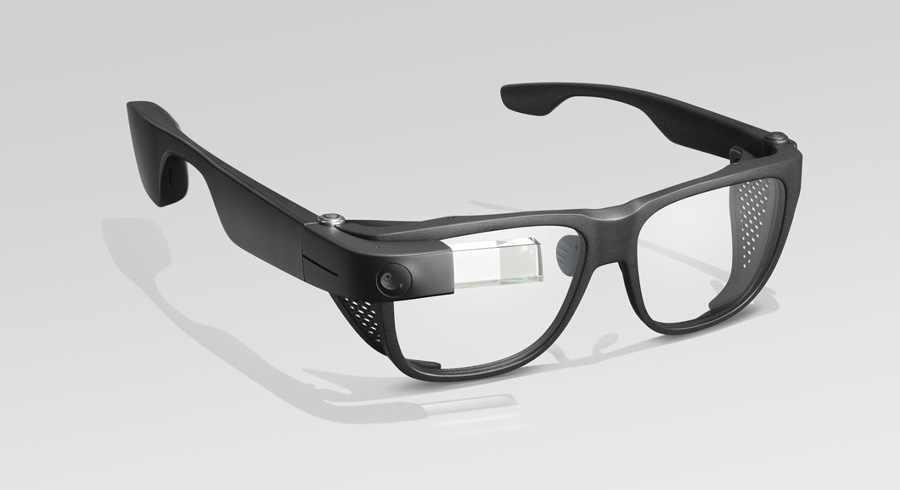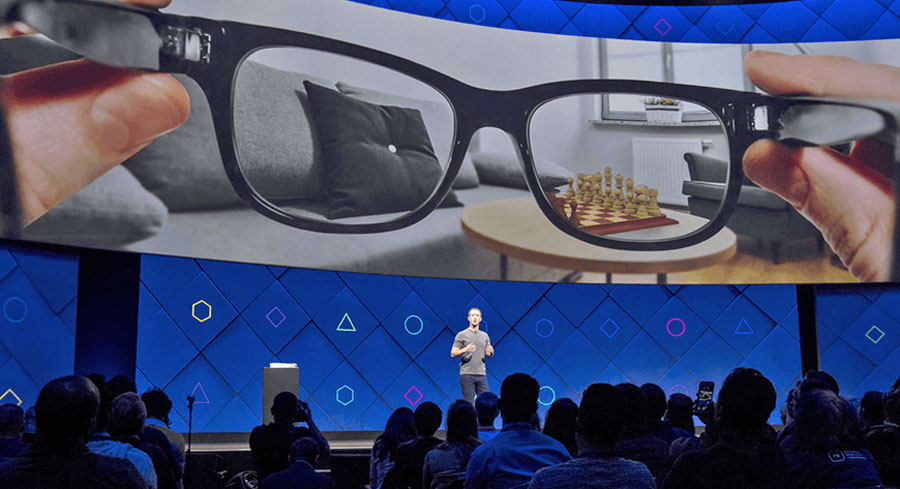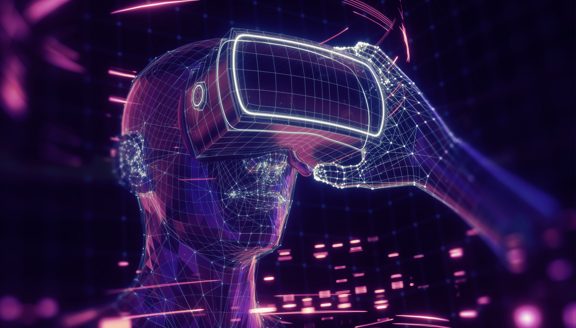Augmented Reality glasses have already traveled a rich yet winding path, and 2021 will be decisive: we are ready to experiment with all the innovations.
Real World and Augmented Reality
Physical objects, the places we live in, or the furniture establish the real spaces within which we move and carry out our daily activities.
We become aware of them by continuously using our five senses, from sight to touch, but we can enrich them through imagination.
We can define Augmented Reality as the point of tangency between the physical world we perceive and the digital content connected to the real world, which is enhanced with new information and meanings. This is where new emotions arise.
When We Started Talking About Augmented Reality
In 1966, Ivan Sutherland, one of the pioneers of computer graphics, developed a device called “The Ultimate Display,” also known as the “Sword of Damocles” due to the menacing mechanical arm that kept it suspended from the ceiling. It is considered the first virtual reality headset, although it would take a few more decades until Jaron Lanier coined the term “Virtual Reality” in 1989.
When we wear a headset, we accept that our mind separates from the physical location while remaining physically present. This led to the need to develop software capable of recognizing objects around us and allowing us to insert additional information such as holograms and virtual objects in both 2D and 3D.
Thus, Augmented Reality was born, becoming a compromise between the entirely real world and the completely virtual world.
In 1990, Thomas Caudell, along with David Mizell, an engineer at Boeing, used the term “Augmented Reality” to describe a device that assists workers in cable assembly for aircraft. However, it would take another ten years for Augmented Reality to emerge from research laboratories.
Research on the Most Suitable AR Device (and a Bit of History)
For years, work has been done on the development of software and hardware for augmented reality.
For a long time, devices for Augmented Reality visualization were limited to webcams and phones, as traditional VR headsets were too bulky and ergonomically unsuitable. There was a need to find a device that could project digital information in front of our eyes without losing communicative contact with the surrounding environment.
Something that could fully immerse us in the perception of an augmented world, enabling us to visualize holograms, share emotions simultaneously with others, and, above all, free our hands to interact with the environment. It had to be lightweight, wearable, and easily manageable, just like a pair of glasses.
Vuforia was one of the first AR software development groups for mobile devices that invested in and used computer vision technology to recognize and map 3D images and objects in real-time.
In 2012, developers at Valve (an American company that had launched STEAM for PC game sales in 2003) who had been working on a prototype of AR glasses, thought of combining Virtual Reality technology with the real world by reproducing 3D images through small miniature projectors attached to the glasses.
Jeri Janet Ellsworth, a hacker and computer chip inventor, hired and later fired by Valve in 2013, after founding her startup Technical Illusions, announced the development of an Augmented Reality system called castAR, in collaboration with her former Valve colleague, Rick Johnson. The system combines elements of Augmented Reality with elements of Virtual Reality.

Glass Enterprise Edition 2 with safety frames by Smith Optics.
In 2013, Google introduced its Augmented Reality glasses, the Google Glass, developed by Foxconn: the glasses that everyone has heard of. Although the predictions were very positive, the project declined in 2016, and the glasses were withdrawn from the market due to privacy-related issues.
Mark Elliot Zuckerberg immediately recognized the power of this new technology and invested over the years by acquiring software developed by startups (such as Ctrl-Labs, which uses neural interface technology) and applications like Instagram and WhatsApp. But most importantly, he provided developers with access to the SparkAR platform to create Augmented Reality filters for Instagram. Through Facebook for Developers, he allowed users to use some open-source tools and, with Facebook Reality Labs, he disseminated news about Augmented Reality, Virtual Reality, and Artificial Intelligence.
But now, let’s move on to buying recommendations.
WHAT ARE THE MOST WELL-KNOWN AUGMENTED REALITY GLASSES TODAY?
Below is a brief list of the main Augmented Reality glasses available on the market today, including some models that handle mixed reality, which we include for simplicity’s sake.
Among the most well-known are:
- Microsoft Hololens 2 / Microsoft, widely used in the industrial sector for mixed reality
- Magic Leap glasses, which use a technology known as light field photonics
- NReal
- Lenovo Mirage / Lenovo, paired with Jedi Challenges game, compatible with Android and iOS
- ZapBox / Zappar, a radical new approach to 6-DoF MR and VR powered by smartphones
- Epson Moverio BT-300 Smartglass Binoculars / Epson, compatible with Android
- Glass Enterprise Edition 2 / Google, compatible with Android and iOS
- Vuzix Blade AR Smart Glasses / Vuzix, compatible with Android, iOS, and Alexa. The glasses support video streaming from Netflix, Amazon Prime Video, and others.
- Varjo XR2
- TiltFive
- Project North Star
- Magic Mask, compatible with all types of smartphones
- Ray-Ban Stories
The choice to purchase these glasses is certainly subjective and depends on economic and application-related factors. It is necessary to understand the ultimate purpose of their use and make a preference based on the actual need.
Augmented Reality Glasses: Current News and Future Insights
An important event shapes the future of Augmented Reality glasses: on September 16, 2020, Facebook and EssilorLuxottica (known for Ray-Ban) announced, through Mark Zuckerberg, their multi-year collaboration for the development of a pair of smart glasses to experience Augmented Reality under the Ray-Ban brand. This partnership combines Facebook’s technology and apps with Luxottica’s category leadership, iconic brands, elegance, and Essilor’s lens technology, bringing AR glasses closer to a fashion product. And thus, within a year, the Ray-Ban Stories were introduced to the public in September 2021.

Mark Zuckerberg, durante la conferenza annuale di Facebook.
In the ongoing competition between Apple and Facebook, another current topic is the launch of the iPhone 12.
The noteworthy aspect is that this version was the first to be equipped with a LiDAR scanner, a particular technology for digital environment scanning, offering users the opportunity to experience augmented reality like never before. But we have already discussed this in detail in our analysis.
It should also be mentioned that Facebook, through its Project Aria, not only made the first pair of glasses a reality but will also invest heavily in the possible advancements of this technology to achieve the “ultimate” product in just a few years.
In this journey, the miniaturization of devices, along with progress in complementary technologies such as 5G and Remote Rendering, will be strong enablers.
Conclusion
Augmented Reality glasses have already traversed a fairly rich albeit challenging path. However, the future appears to be well-charted, with a plethora of products set for release and a relatively close point in time where we will all wear them in our daily lives. Moreover, they will increasingly detach from our phones, becoming connected objects with stylish designs. For example, we will use them to view information and hazard signals on the streets, read holographic displays of ingredients, recipes, or promotions in supermarkets, quickly check instructions for repairing machinery, or immerse ourselves in exclusive worlds and stories, as we have already done with our app Mr. Fini – The Experience for the launch of Gué Pequeno’s latest album. 2021 will be a decisive year, and we are ready to experience all the innovations.


